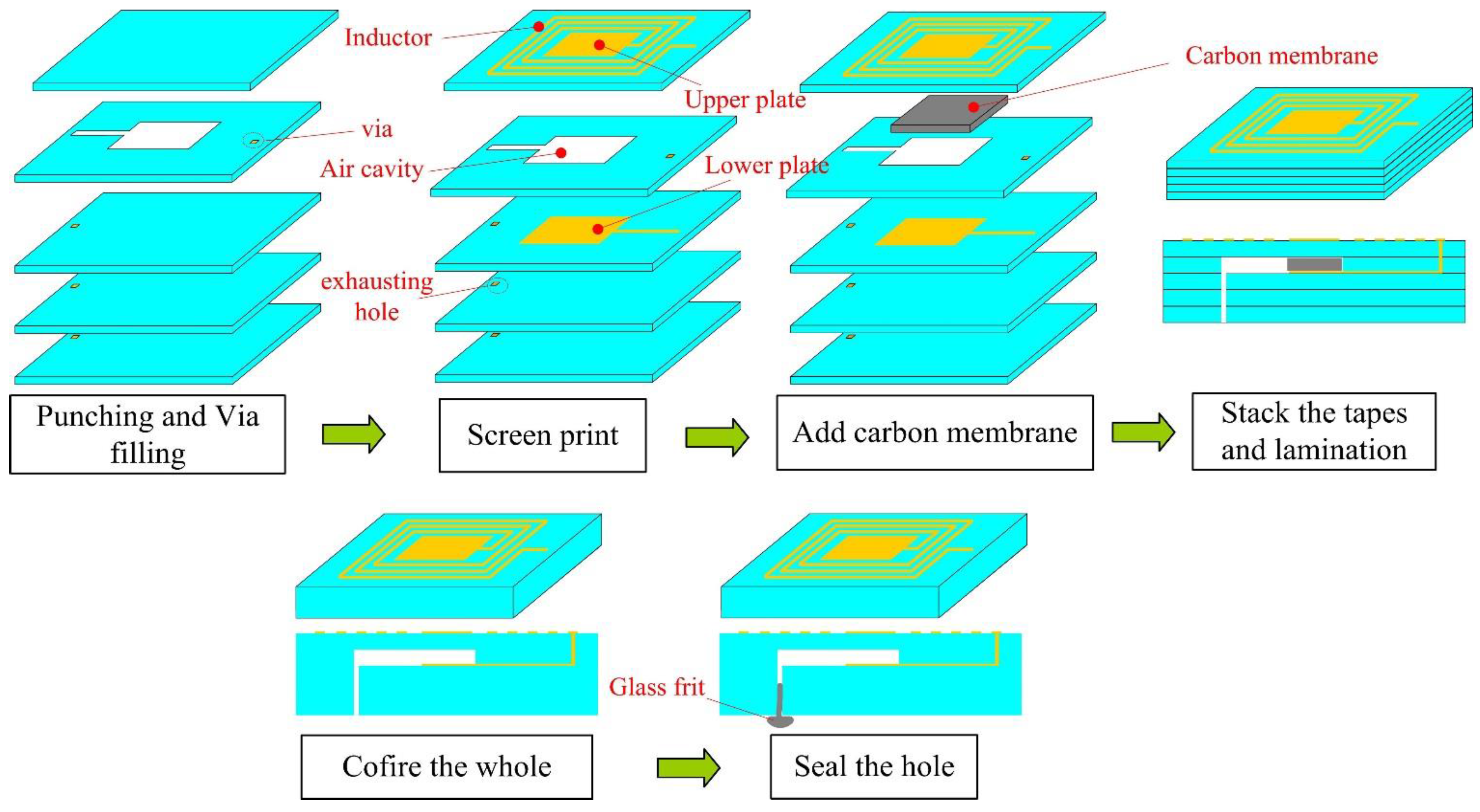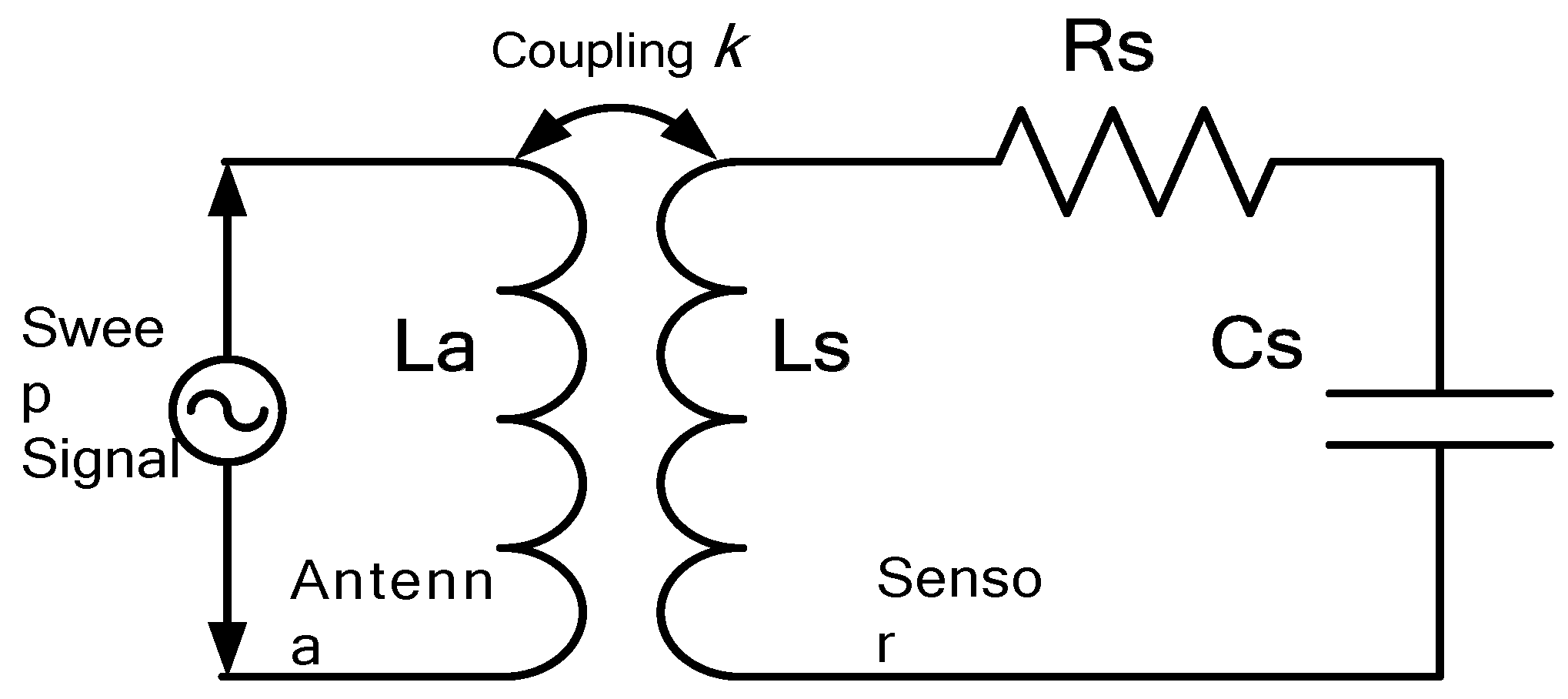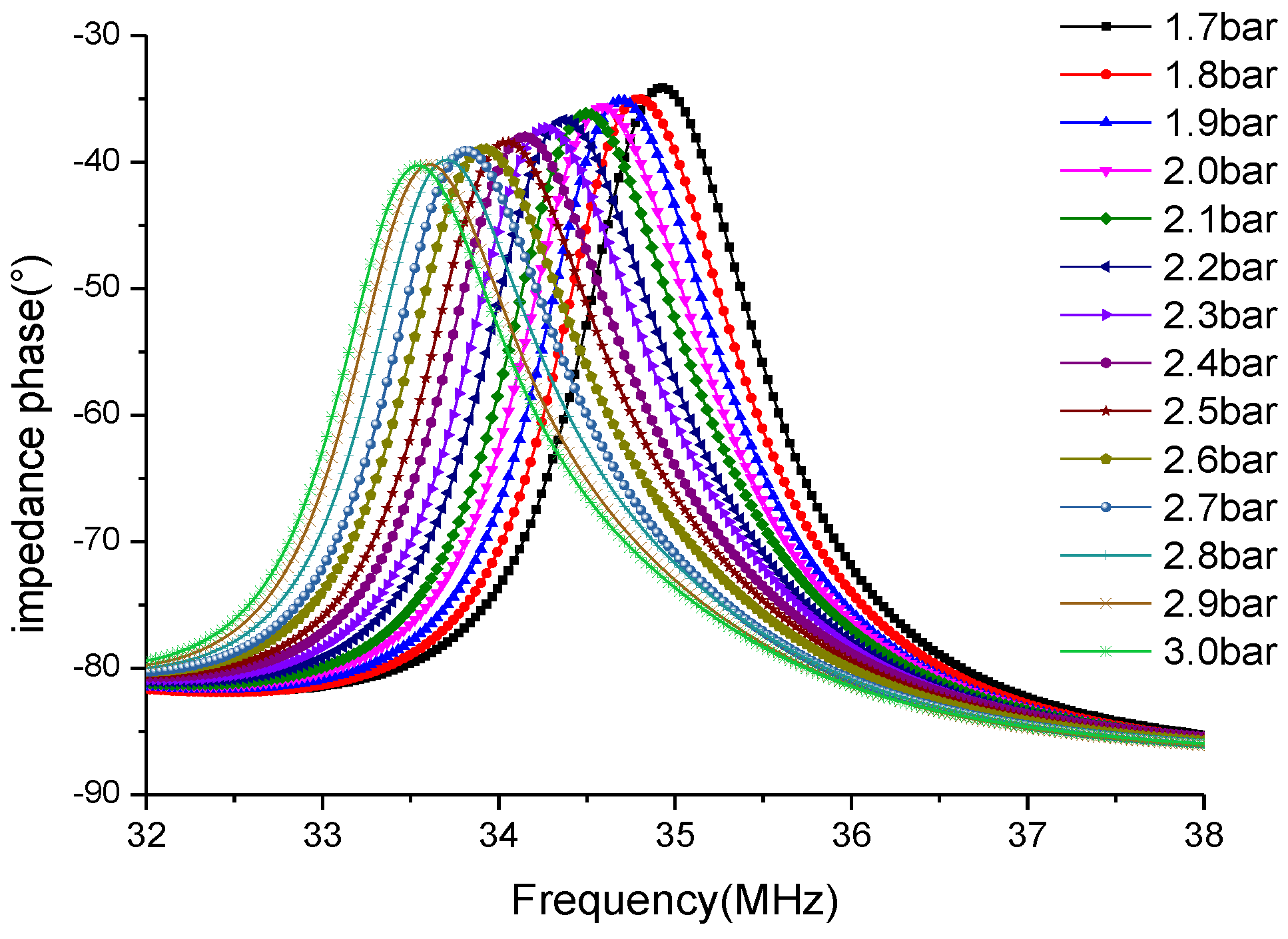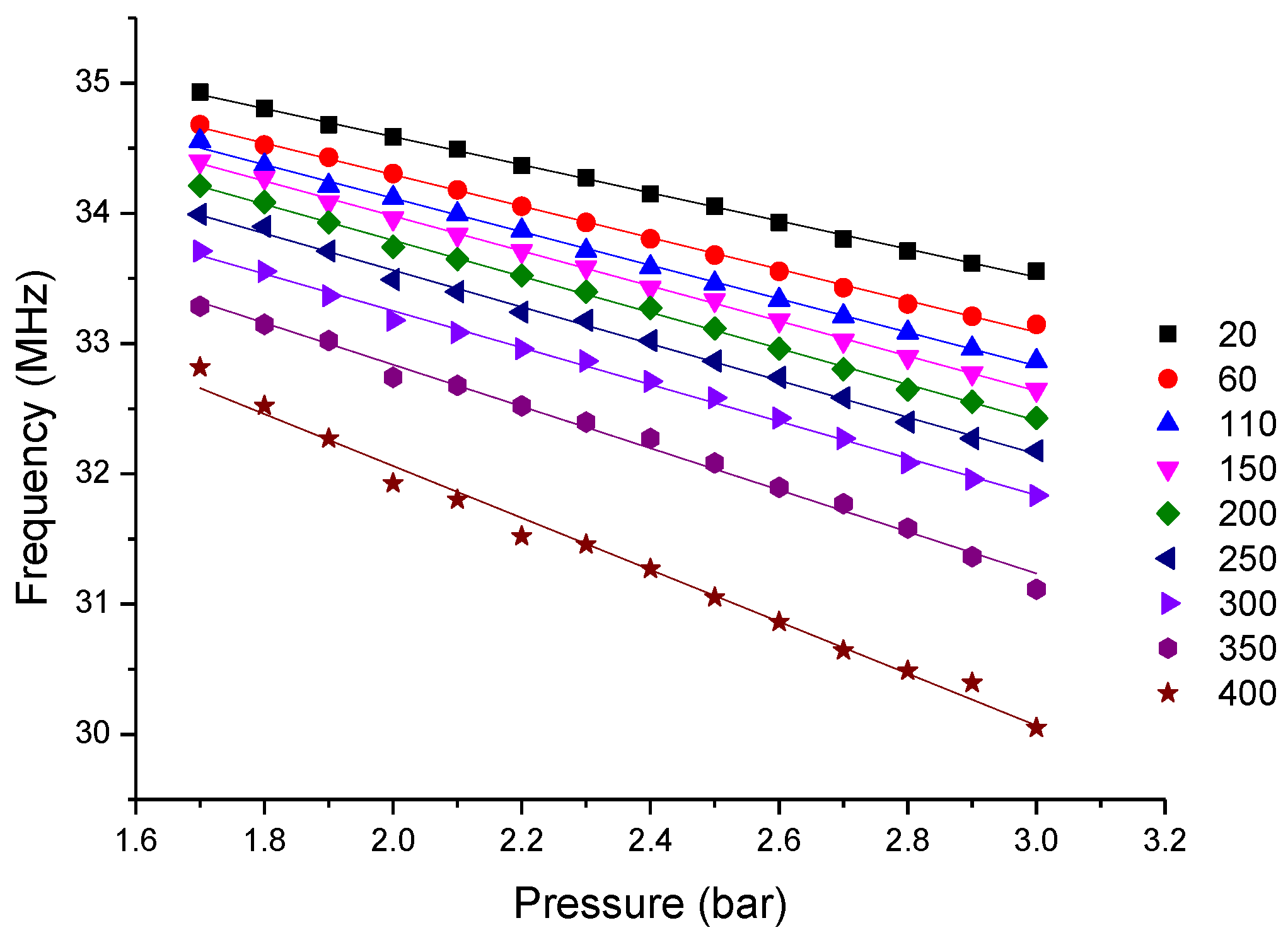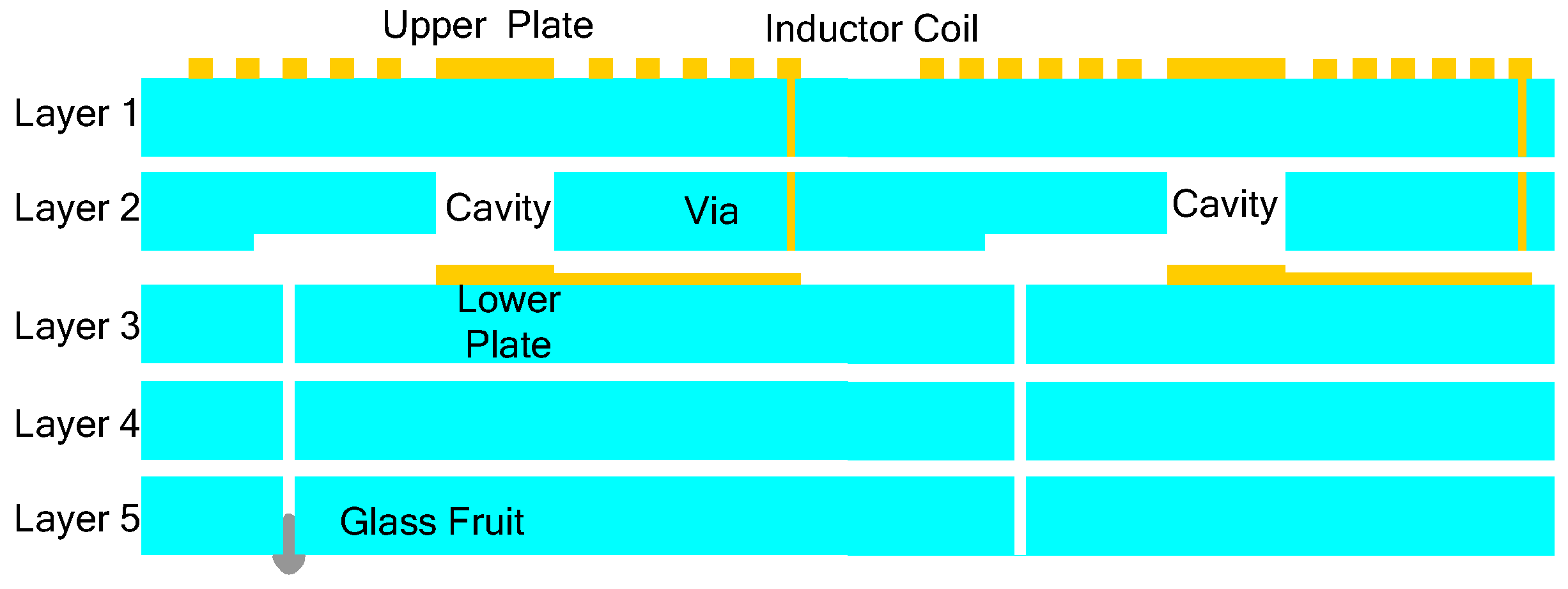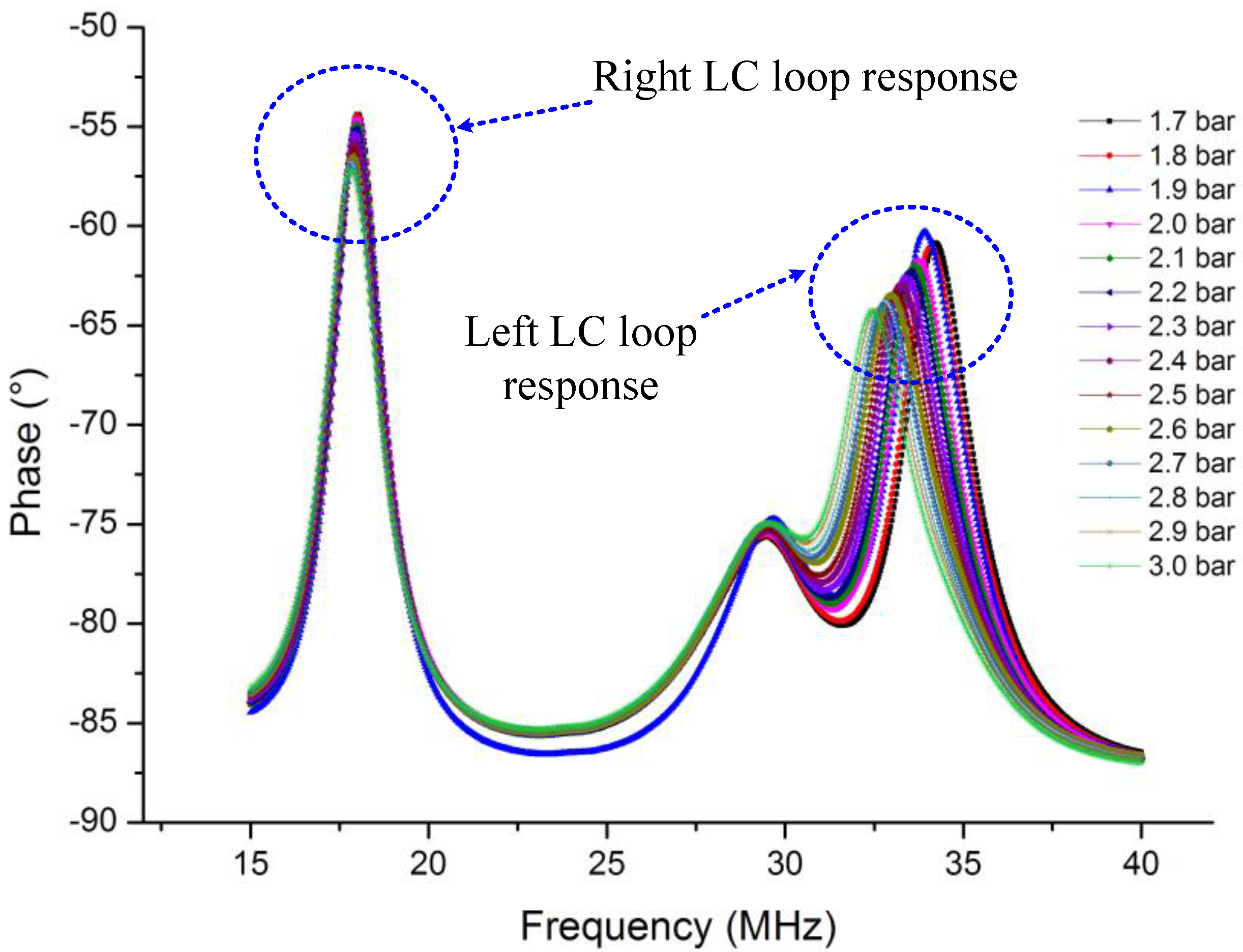1. Introduction
Low-temperature co-fired ceramic (LTCC), developed by the Hughes company in 1982, is a new type of ceramic material. LTCC, which is mainly composed of ceramic particles, glasses, and organic composition, can form a green tape of uniform thickness and density. Through the standard LTCC fabrication process, including steps such as punching, screen printing, stacking, and co-firing, a high-density circuit structure can be fabricated [
1,
2,
3]. Because LTCC exhibits excellent merits for miniaturization, high integration, and compatibility, this technique has been widely used in fields such as high-frequency and microwave signals, especially combined with wireless passive sensing technology, making it widely used in high-temperature pressure measurement [
4,
5].
Wireless passive pressure sensors based on LTCC were first developed at the Georgia Institute of Technology in 1999. By introducing an air cavity inside the ceramic, the sensor resonant frequency was made sensitive to external pressure [
6]. In 2002, Fonseca improved this structure and made this sensor applicable for a higher temperature range [
7]. In the following years, the Vienna Technology University (Austria) and Novi Sad University (Serbia) proposed a pressure sensor structure that completely embedded the inductor and capacitor into the ceramic body, in order to protect the sensor from high temperature and corrosive environments [
8]. Since 2010, North University of China improved the sensor performance by introducing a scarified layer technology during lamination and by improving the structure without an air exhaust hole. Further, it has realized pressure measurements under 600 °C [
9].
The principle and fabrication process of an LC resonant sensor based on DuPont 951 ceramic are first introduced in this paper. Then, the fabricated sensor is tested on the developed high-temperature/pressure complex test system. The results indicate that high temperature causes drift and changes in the response sensitivity of the measured signal. From the in-depth theoretical analysis of the sensor structure model, it is found that high temperature causes an increase in the ceramic dielectric constant, and a decrease in the ceramic Young’s modulus. These results indicate that temperature compensation is needed for the LC resonant sensor, which can eliminate the influence of temperature on pressure measurement.
3. Analysis of Sensor Structure Model
The resonant frequency of the LC sensor is defined as:
As shown in
Figure 7a, there is a layer of ceramic and a layer of air cavity between two capacitor plates; thus, the sensor capacitance before deformation is calculated as:
where
d is the thickness of the layer of ceramic tape,
ε0 denotes the permittivity of vacuum, and
εr represents the relative permittivity of the substrate ceramic.
Figure 7.
Pressure sensor model (a) before deformation (b) after deformation.
Figure 7.
Pressure sensor model (a) before deformation (b) after deformation.
When the exerted pressure deforms the sensitive film, shown in
Figure 7b, the capacitance
Cs is given as [
12]:
where:
In Equation (5),
b is a coefficient related to the shape of the capacitor plates,
a denotes the length of the short side of capacitor plate, and
v and
E represent the Poisson ratio and Young’s modulus of the substrate ceramic, respectively. Δ
p is the pressure difference between the exerted nitrogen pressure
po and internal pressure
pi of the sealed cavity, and is calculated as:
Combining Equations (5) and (6), the coefficient
β is roughly calculated as 10
−1 in order of magnitude. When Taylor expansion is performed on Equation (4) and the higher-order terms are omitted,
Cs is expanded as:
Substituting Equation (7) into Equation (2),
f0 is derived as:
Because
β is small, Equation (8) undergoes further Taylor expansion and the higher-order terms are omitted once again; simultaneously combining Equations (5) and (6),
f0 is calculated as:
where:
When the temperature rises, the sensor inductance
Ls is seen as invariable according to previous experiments [
13]. High temperature will expand the ceramic size; the thermal expansion coefficient of DuPont 951 ceramic is 5.8 × 10
−6/°C. The ratio of plate gap
d to plate area
s is calculated to be reduced by 0.00058% within 400 °C. Therefore, the change of coefficient
A in Equation (11) can be ignored; namely, it can be seen as a constant, within the measuring temperature range.
Figure 6 illustrates that for the same pressure, the measured frequency decreases at elevated temperatures, which indicates the decrease of coefficient
D in Equation (9). When the temperature rises, the air within the sealed cavity expands to balance the exerted gas pressure. Thus, the air pressure
pi inside the cavity approximately equals the external gas pressure
p0. The coefficient
C, the slope of the fitted curve, simultaneously increases at elevated temperatures. Therefore, it is inferred that the coefficient
B in Equation (10) decreases at elevated temperatures. The expression of
B illustrates that the relative permittivity of substrate ceramic
εr increases at elevated temperatures. By in-depth analysis,
εr is found to increase from 7.8 to 8.1 within 400 °C, which is why the measured frequency shifts downward at elevated temperatures for the same pressure.
When the temperature is invariable, the sealed air cavity is compressed at elevated nitrogen pressure, causing the air pressure
pi of the sealed cavity to increase to some extent. It is shown in
Figure 6 that the measured frequency has an approximately linear relation with exerted pressure
p0; thus, it is reasonable to see the coefficient
C as the slope of the fitted curve.
According to the expression of coefficient
C, when the temperature increases from 20 °C to 400 °C, the ratio of
a4 to
d4 is seen as approximately invariable, whereas the variation of substrate ceramic permittivity causes the coefficient
C to increase by a factor of only approximately 0.002, which differs from the substantial change of coefficient
C. Therefore, it is inferred that the variation of substrate ceramic Young’s modulus could be the main reason causing the change. Ignoring the minimal change of dimensional proportion, variation of substrate permittivity etc minor factors, the coefficient
C is found to be an inverse ratio with variable
E. Thus, Young’s modulus of LTCC at different temperatures can be calculated approximately as:
where
E0 and
C0 are Young’s modulus of LTCC and slope of the measuring curve at room temperature respectively [
14]. Young’s modulus of LTCC at different temperatures can be derived.
Figure 8 illustrates that the Young’s modulus of LTCC always decreases at elevated temperatures, especially above 300 °C. The Young’s modulus of LTCC is calculated to decrease to 65 GPa within 400 °C, which illustrates that the material becomes softened at high temperatures, causing the sensitive membrane to deform further under the same pressure.
Figure 8.
Calculated Young’s modulus of LTCC at different temperatures.
Figure 8.
Calculated Young’s modulus of LTCC at different temperatures.
4. Temperature Compensation Structure of the Sensor
From the above analysis, it is known that temperature significantly affects the measurement of LTCC-based pressure sensors. Therefore, a temperature compensation structure is needed for the pressure sensor to eliminate the influence of temperature on pressure measurement. In particular, when exploring temperature compensation, focus should be on the effect of temperature on the variation of substrate ceramic permittivity and Young’s modulus.
Figure 9 shows the proposed temperature compensation structure. The left LC loop is for pressure measurement, which is the same as the structure shown in
Figure 1. Meanwhile, another LC loop, next to the left LC loop, is introduced for temperature measurement. The temperature capacitor structure is the same as that of the left sensor, which contains a layer of ceramic and a layer of air cavity; the two inductor shapes are different, to keep the two measured frequencies apart. The right via has no sealant, and the permittivity of LTCC is known to increase monotonously at elevated temperatures; thus, the right LC loop can be used for measuring temperature.
Figure 9.
Temperature compensation structure for complex environments.
Figure 9.
Temperature compensation structure for complex environments.
Because the two inductor coils do not overlap, the coupling between the sensor coils is negligible. The influence of crosstalk between the sensor coils can be ignored; thus, the resonant frequency of the temperature sensor is calculated as:
Combining Equation (13) with Equations (4), (5) and (8), the exerted pressure can be derived as:
By the right LC loop resonant frequency f1, the temperature can be obtained; thus, Young’s modulus E(t) for the changed temperature is acquired. By substituting E(t) and the two measured frequencies f0 and f1 into Equation (14), the external pressure after temperature compensation is obtained; thereby, the impact of high temperature on the sensor pressure measurement can be eliminated.
In order to prove the above analysis, the proposed temperature compensation structure of
Figure 9 is fabricated and tested under the same developed high-temperature/pressure complex environments.
Figure 10 illustrates the pressure response curve of the compensation structure at 200 °C; the right peak is the response of the pressure sensing element, and the left peak is the response of the temperature sensing element.
Figure 10.
Proposed compensation structure pressure response in 200 °C.
Figure 10.
Proposed compensation structure pressure response in 200 °C.
The two extracted frequencies are substituted into Equation (14), and the pressure sensing element response after temperature compensation is shown in
Figure 11. The influence of temperature on pressure measurement is found to decrease obviously compared with that in
Figure 6. However, the temperature drift cannot be completely eliminated; the main reason is the negligence of coupling between the inductors and calculation errors of variables (such as inductances).
Figure 11.
Measured curve of the pressure sensing element after temperature compensation.
Figure 11.
Measured curve of the pressure sensing element after temperature compensation.
